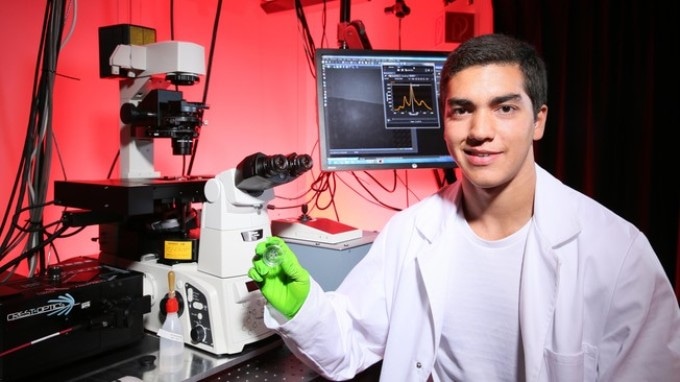Aug 7 2017
Edward Honein has joined the Laboratory of Nanobiotechnology at EPFL from the American University of Beirut. Under the guidance of Professor Ardemis Boghossian, Honein’s summer project aims to develop a nanotube-based biosensor.
 Edward Honein holding a microfluidic nanotube biosensor. © Alain Herzog/EPFL
Edward Honein holding a microfluidic nanotube biosensor. © Alain Herzog/EPFL
Biosensors are devices that can detect biological molecules (“analytes”) in blood, air or water. They are increasingly being used in the fields of biological research, medical diagnostics, drug development and even security. In spite of ongoing advancements, there is still a demand for enhanced portable bio sensing devices that are convenient to use for Doctors as well as patients. The development of such devices would provide methods for continuous, real-time monitoring of biomarker levels, which is essential for a number of diseases such as diabetes.
Edward Honein’s summer project plays a major role exactly in this situation: He is specifically designing an optical, microfluidic biosensor that can detect single biomolecules in a scalable, high-throughput method.
The biosensor itself is made up of carbon nano tubes, which are rolled-up sheets of graphene. Nanotubes have lengths up to several centimeters and diameters as small as 1 nanometer. Their unique physical properties have paved the way for a whole new world of technologies. One of these properties is emitting light in the near-infrared spectrum (700 to 2500 nm wavelength) when excited with a laser.
Honein’s project draws from the research of Professor Ardemis Boghossian, who heads the lab and brings together biological molecules and nanotube optics to study a range of emerging abilities, including near-infrared biosensing. In her research, Boghossian has exclusively designed nanotubes wrapped with single-stranded DNA, which serves as the authentic sensing molecule for the target analyte.
In our applications we use semi conducting nanotubes that have a specific energy barrier, called the ‘band gap’. When we excite the nanotubes with a laser, an electron is excited across this barrier into the conductance band. Eventually this electron relaxes, and in doing so releases a photon – which is what we see as emitted light.
Edward Honein, the American University of Beirut
When a protein or the DNA identifies the presence of a target molecule in the proximity of a carbon nanotube, the resulting interaction modifies the 3D conformation of the DNA or protein, which in turn affects the surface properties of the nanotube. These modifications affect the near-infrared light emitted by the nanotube and modifies its signal.
Honein is now taking efforts to streamline the biosensor to make it suitable for commercial use. This calls for a lot of work: initially to construct the biosensor, then to characterize the sensor’s selectivity and sensitivity, and finally to incorporate the sensor into a working device. One possibility he is investigating is using DNA-wrapped nanotubes that have been immobilized into a gel, and then incorporating this gel into a microfluidic device.
When you add your analyte, the signal of the emitted light changes – so you know you detected something. But depending on how nanotubes are dispersed in the gel, the intensity may change from experiment to experiment, which is inconsistent.
Edward Honein, the American University of Beirut
“We have these sensors, they're coming out, they're promising, they can detect biomolecules of interest so it's beyond proof-of-concept,” adds Boghossian. “And at this point, what we're trying to do is package it into something accessible, and even portable - such as a microfluidic device.”
Ultimately, the purpose and design of such devices are limited by the capabilities of their nanotubes, which emit light at different wavelengths based on their diameters. “Because they have different band gaps, they fluoresce at different wavelengths,” says Honein. “So you look at this wavelength of light and know that you’re detecting molecule X; then this wavelength of light means you’re detecting molecule Y."
By taking advantage of this property, sensors can be designed with the ability to detect multiple molecules at the same time using different wavelengths of light. This provides a particular advantage when performing multi-analyte analysis on more complex samples, such as blood serum, cerebrospinal fluid, urine, and even opaque fluids like blood itself.